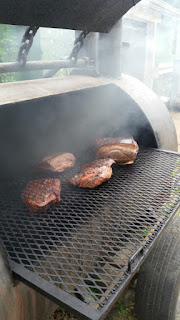 |
| Weak but pervasive |
 |
| Poa (light green) in a tee |
Annual Bluegrass is an annual and a major component of golf course greens tees and fairways of older courses in cool/temperate, moist climates like those in the northeast and pacific northwest. It makes excellent golf turf when conditions are suitable for it to thrive. Many professional golf tournaments are played on it and hundreds of older famously manicured golf courses tolerate it as a component of their closely mowed areas. Tuscarora boasts it's high quality Annual Bluegrass greens as some of the finest examples of Poa in upstate New York.
 |
| Heat intolerant |
The downside to Annual Bluegrass is that it's an annual and will usually die in extreme prolonged heat. Technically, and literally, it has evolved to weaken or die in high heat and drought. This is normal. It's evolved to deal with this, by seeding prolifically in the spring and early summer so the voids it leaves when dead will have been "pre-seeded" by itself. It's so good at this that golf courses in the northeast apply seedhead retardant to keep turf playable. In the northeast we don't see prolonged heat and drought. Poa, for this reason, often lives as a perennial. The fact that it's supposed to die in the heat of the summer is easily forgotten in the northeast as our temperatures are rarely too hot for too long, and we get regular rainfall through the summer. It's forgotten until we have a summer like we had in 2016. Possibly, if the global warming trend continues for the next 10-20 years (whatever the cause), Poa annua will be expressing it's true annual nature in summers to come.
 |
| Poa's fate in many hot climates |
Two bio-types of Poa annua naturally predominate on golf courses. There's a true annual or "wild-type" that normally dies in the summer if temperatures weaken it to that point, or weaken to a point that disease can overtake it. This is the type we commonly see in our fairways and to a lesser extent in our approaches and tees. It's the type we saw fail after labor day as the heat continued into its third month.
The other bio-type is one called 'reptans' which is known as a true perennial type. This is the type we see in our greens and tees. It's less prone to heavy seeding, and can be maintained at very short cutting heights. 'Reptans' is a great putting surface, but it is extremely sensitive to drought, over-wetness, and heat as we witness every year on our second green or on any green that has slow draining areas.
 |
| In cooler climates poa makes a striking contrast and putts well |
The dilemma with Poa is that it's a great grass on a typical year. You don't want to do anything to harm it. It's a great performer when all of it's requirements are met. So, if there's patience and understanding, when you have the off year when it doesn't perform, it isn't that big of a deal - it'll grow back. But most golfers aren't that understanding or patient. Golf season is short in the northeast and there's little time for growing turf back. For this reason there are scores of clubs and greens committees over the decades that have tried to eradicate Poa from their golf courses after experiencing a few bad years. Locally, Oak Hill tried to convert their greens in the 1990's, Bellevue tried to convert their fairways in the late 1980's, and this year Corning CC is attempting to convert two of their fairways from Poa to bentgrass due to major losses. All attempts were only partly successful. They did make gains in adding bentgrass, but ultimately, they end up living with the Poa and getting on a pesticide program that keeps the plant as protected as possible during stress periods. There are chemical eradication programs to keep Poa out of 100% bentgrass seeded/sodded courses, but that requires having mostly bentgrass to begin with (see Lakeshore or Turning Stone).
The USGA has a few good pieces on what super heated summers do to Poa annua playing surfaces. It's failure is well documented.
http://www.usga.org/articles/2010/08/heat-straining-golf-courses-2147489488.html
https://www.usga.org/course-care/regional-updates/northeast-region/a-summer-brawl.html
http://www.turfdiseases.org/northeast/outbreaks-of-mysterious-pythium-disease-on-golf-courses/
 |
| Healthy ryegrass surrounding dead Poa annua in our fairways |
The programs in place on our greens and tees are successful practices that I've seen keep grass healthy through tough weather conditions. They're also the methods I use on our most at-risk fairways (10, 11, 12). They're proven and work well keeping healthy turf on those areas. Historically, there hasn't been a widespread preventative fungicide program for Tuscarora fairways. To put a finer point on it, consider this from the USGA on greens care - the same philosophy applies to fairways:
Maintain a solid fungicide program: With heat, humidity and thunderstorms, fungicides do not last as long and disease pressure is greater. There is no better money spent than in protecting the grass from disease. If the fungicide budget is being depleted, pull back in other areas. However, when conditions are this difficult, fungicides often cannot completely overcome disease incidence. It may well be a case of reducing disease injury rather than eliminating it altogether.That all said, there is no silver bullet. As a secondary measure we've purchased our own large-area slit seeding machine and will be returning to interseeding a tougher plant into the fairways. It's an altogether different genus that's resistant to drought, heat, shade, and many diseases. This will help improve our fairways by making them more resilient and diverse. It's the same grass we use in our divot mix on tees and fairways and performs well there. It's a fine turf that's hard to kill.























































